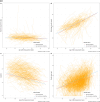Marital and living status and biological ageing trajectories: a longitudinal cohort study with a 20-year follow-up
- PMID: 39775304
- PMCID: PMC11711563
- DOI: 10.1007/s10522-024-10171-1
Marital and living status and biological ageing trajectories: a longitudinal cohort study with a 20-year follow-up
Abstract
Biomarkers of ageing (BA) can predict health risks beyond chronological age, but little is known about how marital/living status affects longitudinal changes in BA. We examined the association between marital/living status and BA over time using the-Swedish-Adoption/Twin-Study-of-Aging (SATSA) cohort. Four BAs were analyzed: telomere length (TL) (638 individuals; 1603 measurements), DNAmAge (535 individuals; 1392 measurements), cognition (823 individuals; 3218 measurements), and frailty index (FI) (1828 individuals; 9502 measurements). Individuals were born between 1900 and 1948, and data on marital/living status, BAs, and covariates were collected through nine waves of questionnaires and in-person testing from 1986 to 2014. Mixed linear regression with random effects at twin-pair and individual levels were used to assess BA changes for constant marital/living status. Conditional generalized estimating equation assessed within-individual BA changes for varying marital/living status. Results showed that individuals who were consistently unmarried/non-cohabiting (β = 0.291, 95%CI = 0.189-0.393) or living alone (β = 0.203, 95%CI = 0.090-0.316) were more frail, and experienced accelerated frailty (p-for-interaction with age < 0.001 for marital status; p-for-interaction = 0.002 for living status) and cognitive decline (p-for-interaction < 0.001), compared to those married/cohabiting or living with someone Among individuals whose marital/living status changed, frailty was higher when living alone (β = 0.089, 95%CI = 0.017-0.162) and frailty accelerated when they became unmarried/non-cohabiting or were living alone (p-for-interaction < 0.001). Cognitive decline also accelerated when living alone (p-for-interaction = 0.020). No associations were observed for TL and DNAmAge. In conclusion, being unmarried/non-cohabiting or living alone from mid-to-old age is linked to accelerated cognitive decline and frailty. These findings highlight the potential importance of social support networks and living arrangements for healthy ageing.
Keywords: Ageing trajectories; Biological ageing; Cognition; Cognitive function; Frailty; Living status; Longitudinal; Marital status; Telomere.
© 2025. The Author(s).
Conflict of interest statement
Declarations. Conflict of interest: We declare no competing interests and confirm the independence of researchers from funders. Ethical approval: All participants provided informed consent. This study has received ethical approval from the Regional Ethics Review Vetting Board, Stockholm (Dnr 2015/1729-31/5).
Figures



Similar articles
-
Longitudinal trajectories, correlations and mortality associations of nine biological ages across 20-years follow-up.Elife. 2020 Feb 11;9:e51507. doi: 10.7554/eLife.51507. Elife. 2020. PMID: 32041686 Free PMC article.
-
Marital Status and Risk of Physical Frailty: A Systematic Review and Meta-analysis.J Am Med Dir Assoc. 2020 Mar;21(3):322-330. doi: 10.1016/j.jamda.2019.09.017. Epub 2019 Nov 16. J Am Med Dir Assoc. 2020. PMID: 31740150
-
Marital status, telomere length and cardiovascular disease risk in a Swedish prospective cohort.Heart. 2020 Feb;106(4):267-272. doi: 10.1136/heartjnl-2019-315629. Epub 2019 Nov 14. Heart. 2020. PMID: 31727634
-
Association between non-insulin-based insulin resistance indicators and frailty progression: a national cohort study and mendelian randomization analysis.Cardiovasc Diabetol. 2025 Jan 22;24(1):31. doi: 10.1186/s12933-025-02597-9. Cardiovasc Diabetol. 2025. PMID: 39844267 Free PMC article.
-
Longitudinal association between eating alone and deterioration in frailty status: The Korean Frailty and Aging Cohort Study.Exp Gerontol. 2023 Feb;172:112078. doi: 10.1016/j.exger.2022.112078. Epub 2022 Dec 28. Exp Gerontol. 2023. PMID: 36584805 Review.
References
-
- Blackburn EH, Epel ES, Lin J (2015) Human telomere biology: a contributory and interactive factor in aging, disease risks, and protection. Science 350(6265):1193–1198. 10.1126/science.aab3389 - PubMed
-
- Chen R, Zhan Y, Pedersen N, Fall K, Valdimarsdóttir UA, Hägg S, Fang F (2020) Marital status, telomere length and cardiovascular disease risk in a Swedish prospective cohort. Heart 106(4):267–272. 10.1136/heartjnl-2019-315629 - PubMed
Publication types
MeSH terms
Grants and funding
LinkOut - more resources
Full Text Sources
Medical

